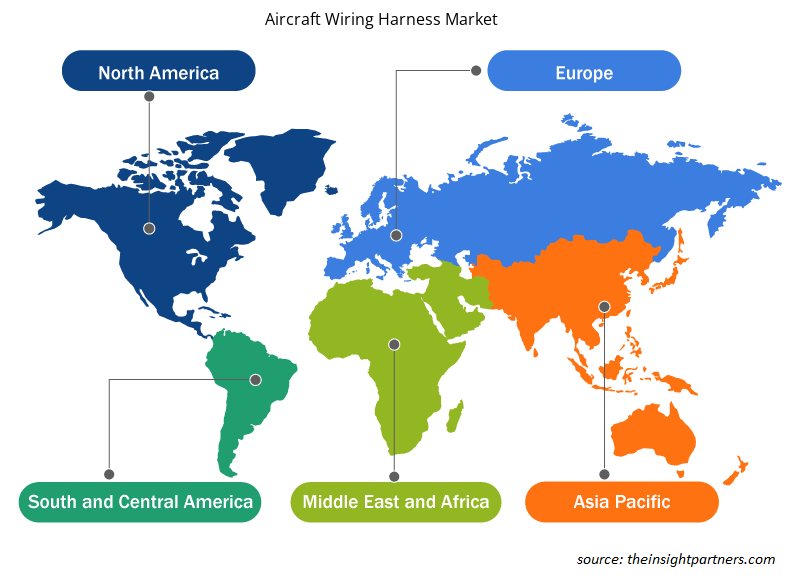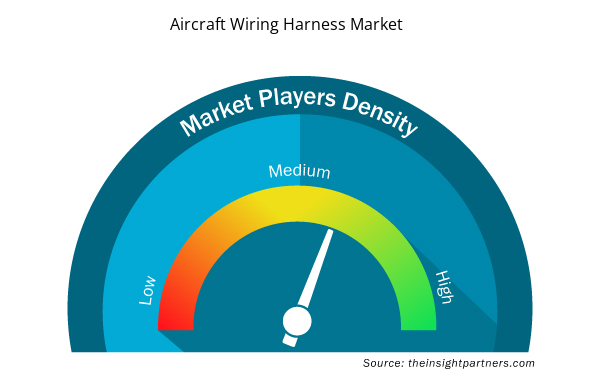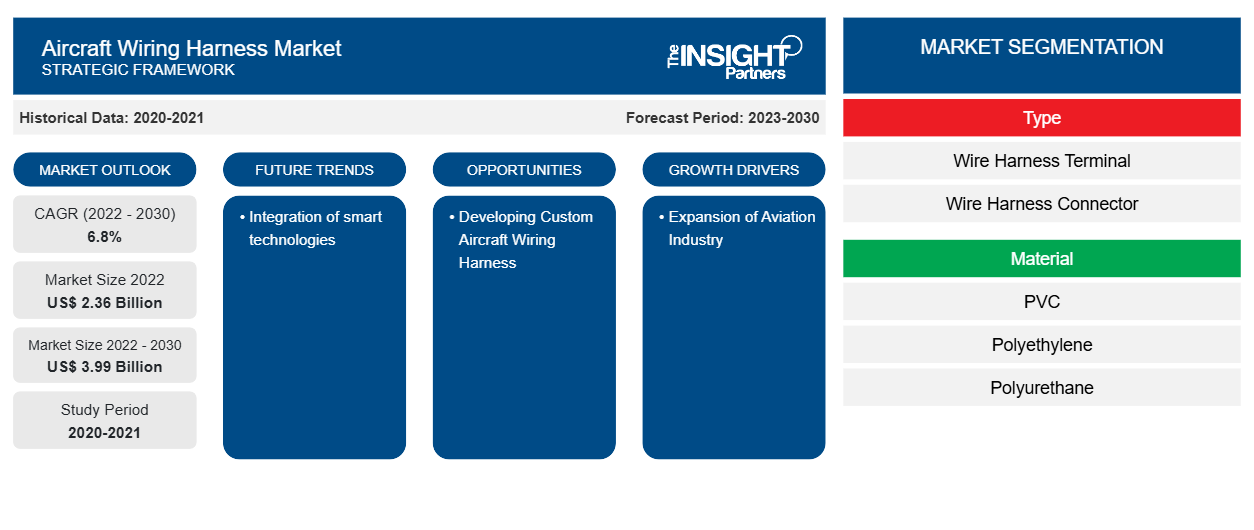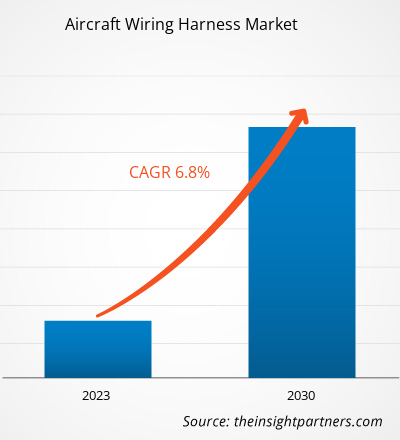Der Markt für Flugzeugkabelbäume soll von 2,36 Milliarden US-Dollar im Jahr 2022 auf 3,99 Milliarden US-Dollar im Jahr 2030 anwachsen. Der Markt dürfte zwischen 2022 und 2030 eine durchschnittliche jährliche Wachstumsrate (CAGR) von 6,8 % verzeichnen. Die Integration intelligenter Technologien dürfte ein wichtiger Trend auf dem Markt bleiben.CAGR of 6.8% during 2022–2030. Integration of smart technologies is likely to remain a key trend in the market.
Marktanalyse für Flugzeugkabelbäume
Kabelbaumhersteller bauen unglaublich komplexe elektrische Kabelbäume und Kabelbaumbaugruppen, die den Betrieb und die Steuerung fast aller Komponenten des Flugzeugs ermöglichen, vom Rumpfkabelbaum bis zur Stromverteilungsbaugruppe. Diese Baugruppen werden häufig in Anwendungen eingesetzt, in denen dichte Verkabelung und komplexe Elektronik erforderlich sind.
Beim Bau von Kabelbäumen für die Luftfahrt werden Hochleistungskabel und -drähte verwendet, die flammbeständig sind und den meisten Kraftstoffen, Lösungsmitteln und Schmiermitteln widerstehen. Kabelbäume für die Luftfahrt werden von Kampfflugzeugen, Cobra-Helikoptern und anderen Flugzeugen verwendet, da sie darauf ausgelegt sind, selbst unter den anspruchsvollsten Umweltbedingungen eine zuverlässige, hohe Leistung zu bieten.
Marktübersicht für Flugzeugkabelbäume
Produkte auf dem Markt für Flugzeugkabelbäume sind für moderne Flugzeuge unverzichtbar, da sie die Übertragung von Strom, Signalen und Daten ermöglichen und einen reibungslosen Betrieb von Flugzeugsystemen gewährleisten. Sie werden in Anwendungen für Motoren, Rumpf, Gondel, Fahrwerk, UAV, Weltraum, Bodenunterstützung und eine Vielzahl von Systemkabelbäumen verwendet. Darüber hinaus werden Flugzeugkabelbäume sorgfältig konstruiert, um die speziellen Anforderungen der Luftfahrt zu erfüllen, wobei verschiedene Aspekte wie Sicherheit, Zuverlässigkeit, Gewichtsreduzierung, Verhinderung elektromagnetischer Störungen (EMI) und Kompatibilität mit extremen Umgebungsbedingungen berücksichtigt werden.
Der Kabelbaum besteht aus mehreren gebündelten Drähten, die zur besseren Übersicht und einfachen Identifizierung häufig farbcodiert sind. Diese Kabel werden präzise verlegt und befestigt, um Spitzenleistung zu bieten, vor Scheuern oder Beschädigungen zu schützen und ein ordentliches und strukturiertes System im Flugzeug zu gewährleisten. Kabelbäume sind für den sicheren und effizienten Betrieb von Luftfahrtsystemen unerlässlich, darunter Avionik, Flugsteuerung, Beleuchtung, Kommunikationssysteme und Unterhaltungssysteme. Diese Systeme sind in Verkehrsflugzeugen, Militärjets und Privatflugzeugen zu finden.
Passen Sie diesen Bericht Ihren Anforderungen an
Sie erhalten kostenlose Anpassungen an jedem Bericht, einschließlich Teilen dieses Berichts oder einer Analyse auf Länderebene, eines Excel-Datenpakets sowie tolle Angebote und Rabatte für Start-ups und Universitäten.
- Holen Sie sich die wichtigsten Markttrends aus diesem Bericht.Dieses KOSTENLOSE Beispiel umfasst eine Datenanalyse von Markttrends bis hin zu Schätzungen und Prognosen.
Treiber und Chancen auf dem Markt für Flugzeugkabelbäume
Ausbau der Luftfahrtindustrie begünstigt den Markt
Mit dem Anstieg des E-Commerce und des Welthandels wächst die Nachfrage nach Lufttransporten für den Warentransport, um den Anforderungen von Unternehmen und Verbrauchern nach schnellen Lieferungen gerecht zu werden. Darüber hinaus stieg der Luftfrachtverkehr laut Boeings Bericht zum Commercial Market Outlook 2022–2041 im Vergleich zu 2020 um 21 % und wird zwischen 2022 und 2041 voraussichtlich um 3,8 % wachsen. Außerdem wird erwartet, dass der Welthandel zwischen 2022 und 2041 um 2,8 % wächst und das Luftfrachtwachstum im gleichen Zeitraum um 3,8 % steigt. Die Luftfahrtindustrie gilt als eine der strengsten, was die Qualitätsstandards für Kabelbaumprodukte betrifft. Kabelbäume, die aus Drähten und Kabeln bestehen, sind für die Übertragung von Daten und Strom zwischen Flugzeugen und Satelliten von entscheidender Bedeutung. Daher erlebt die Luftfahrtindustrie ein erhebliches Wachstum, wobei die Flugzeughersteller die Produktionsraten erhöhen, um die weltweite Nachfrage nach kommerziellen und militärischen Flugzeugen zu decken. Der Anstieg der Anzahl der Flugzeuge fördert die Einführung von Kabelbäumen. Somit treibt die Expansion der Luftfahrtindustrie das Wachstum des Marktes für Flugzeugkabelbäume voran.
Entwicklung kundenspezifischer Flugzeug-Kabelbäume
Die Verwendung anspruchsvoller Materialien ist im Laufe der Zeit bei kundenspezifischen Kabelbäumen für die Luftfahrt immer üblicher geworden. Moderne Kabelbäume für die Luftfahrt werden zunehmend aus leichten und robusten Materialien wie Kohlefaser und Kevlar hergestellt. Diese neuartigen Materialien haben ein gutes Verhältnis von Festigkeit zu Gewicht und bieten wirksamen Schutz vor Hitze, Vibration und elektromagnetischen Störungen. Die Hersteller haben das Gewicht ihrer Flugzeuge effektiv gesenkt und gleichzeitig die Leistung verbessert, was zu einer erhöhten Gesamtflugeffizienz geführt hat. Somit hat die Nachfrage nach leichten Flugzeugen bei den Flugzeugherstellern eine Nachfrage nach kundenspezifischen Kabelbäumen für Flugzeuge geschaffen, was Chancen auf dem Markt geschaffen hat.
Segmentierungsanalyse des Marktberichts für Flugzeugkabelbäume
Schlüsselsegmente, die zur Ableitung der Marktanalyse für Flugzeugkabelbäume beigetragen haben, sind Typ und Material.
- Basierend auf dem Typ ist der Markt für Flugzeugkabelbäume in Kabelbaumklemmen, Kabelbaumverbinder und andere unterteilt. Das Segment der Kabelbaumklemmen hatte im Jahr 2022 einen größeren Marktanteil.
- Basierend auf dem Material ist der Markt in PVC, Polyethylen, Polyurethan, thermoplastische Elastomere und Vinyl unterteilt. Das Polyethylensegment dürfte im Prognosezeitraum wachsen.
Marktanteilsanalyse für Flugzeugkabelbäume nach Geografie
Der geografische Umfang des Marktberichts für Flugzeugkabelbäume ist hauptsächlich in fünf Regionen unterteilt: Nordamerika, Asien-Pazifik, Europa, Naher Osten und Afrika sowie Süd- und Mittelamerika.
Nordamerika meldete im März 2023 einen Anstieg des Flugverkehrs um 51,6 % im Vergleich zu 2022. Die Kapazität zur Beförderung von Passagieren stieg im genannten Zeitraum um 34,0 %, was auf den Fokus auf die Einführung weiterer Flugzeuge in der Region zurückzuführen ist. Darüber hinaus soll im Sommer 2023 mit der Erweiterung des Terminalgebäudes am Kelowna International Airport (YLW) in Kanada begonnen werden. Der Stadtrat von Kelowna hat 90 Millionen US-Dollar für die Erweiterung genehmigt.
Darüber hinaus wurde der Umfang der Flughafenentwicklungspläne in den USA ab Februar 2023 aufgrund der jüngsten Änderungen der Bundesfinanzierungsprogramme erheblich erweitert. Der Chicago O'Hare International Airport, einer der verkehrsreichsten Flughäfen der Welt, hat Pläne bekannt gegeben, 7,1 Milliarden US-Dollar in die Erweiterung zu investieren. Seine älteste Passagieranlage soll abgerissen und ein neues Terminal gebaut werden. Ein weiteres Großprojekt wurde für den Sacramento International Airport angekündigt. Die verschiedenen Phasen dieses Programms werden voraussichtlich 1,3 Milliarden US-Dollar kosten. Ein größeres Angebot an Passagierdiensten soll konsolidiert und die Flughafenanlagen sollen durch sechs Entwicklungsprojekte erweitert werden. All diese Pläne werden in mehreren Bauphasen von 2024 bis 2027 umgesetzt. Daher wird erwartet, dass die Entwicklung der Flughafenanlagen das Wachstum des Marktes für Flugzeugkabelbäume in der Region vorantreiben wird.
Regionale Einblicke in den Markt für Flugzeugkabelbäume
Die regionalen Trends und Faktoren, die den Markt für Flugzeugkabelbäume im Prognosezeitraum beeinflussen, wurden von den Analysten von Insight Partners ausführlich erläutert. In diesem Abschnitt werden auch die Marktsegmente und die Geografie für Flugzeugkabelbäume in Nordamerika, Europa, im asiatisch-pazifischen Raum, im Nahen Osten und Afrika sowie in Süd- und Mittelamerika erörtert.

- Erhalten Sie regionale Daten zum Markt für Flugzeugkabelbäume
Umfang des Marktberichts zum Flugzeugkabelbaum
| Berichtsattribut | Details |
|---|---|
| Marktgröße im Jahr 2022 | 2,36 Milliarden US-Dollar |
| Marktgröße bis 2030 | 3,99 Milliarden US-Dollar |
| Globale CAGR (2022 - 2030) | 6,8 % |
| Historische Daten | 2020-2021 |
| Prognosezeitraum | 2023–2030 |
| Abgedeckte Segmente | Nach Typ
|
| Abgedeckte Regionen und Länder | Nordamerika
|
| Marktführer und wichtige Unternehmensprofile |
|
Marktteilnehmerdichte: Der Einfluss auf die Geschäftsdynamik
Der Markt für Flugzeugkabelbäume wächst rasant, angetrieben durch die steigende Nachfrage der Endnutzer aufgrund von Faktoren wie sich entwickelnden Verbraucherpräferenzen, technologischen Fortschritten und einem größeren Bewusstsein für die Vorteile des Produkts. Mit steigender Nachfrage erweitern Unternehmen ihr Angebot, entwickeln Innovationen, um die Bedürfnisse der Verbraucher zu erfüllen, und nutzen neue Trends, was das Marktwachstum weiter ankurbelt.
Die Marktteilnehmerdichte bezieht sich auf die Verteilung von Firmen oder Unternehmen, die in einem bestimmten Markt oder einer bestimmten Branche tätig sind. Sie gibt an, wie viele Wettbewerber (Marktteilnehmer) in einem bestimmten Marktraum im Verhältnis zu seiner Größe oder seinem gesamten Marktwert präsent sind.
Die wichtigsten auf dem Markt für Flugzeugkabelbäume tätigen Unternehmen sind:
- Safran SA
- Latecoere SA
- GKN Aerospace Services Ltd
- Collins Luft- und Raumfahrt
- Samvardhana Motherson International Ltd
- Herstellung von Kabelbäumen für die Luft- und Raumfahrt
Haftungsausschluss : Die oben aufgeführten Unternehmen sind nicht in einer bestimmten Reihenfolge aufgeführt.

- Überblick über die wichtigsten Akteure auf dem Markt für Flugzeugkabelbäume
Neuigkeiten und aktuelle Entwicklungen zum Markt für Flugzeugkabelbäume
Der Markt für Flugzeugkabelbäume wird durch die Erhebung qualitativer und quantitativer Daten nach Primär- und Sekundärforschung bewertet, die wichtige Unternehmensveröffentlichungen, Verbandsdaten und Datenbanken umfasst. Nachfolgend sind einige der Entwicklungen auf dem Markt für Flugzeugkabelbäume aufgeführt:
- Die elektrischen Kabelbäume der brandneuen Falcon F10X werden von Safran an Dassault Aviation geliefert. Das Unternehmen wurde ausgewählt, um die innovativsten Kabelbäume zu liefern, für deren Herstellung spezielle Technologien und Fertigungsverfahren eingesetzt werden müssen. (Quelle: Safran SA, Unternehmenswebsite, Oktober 2022)
- Safran, ein bekanntes französisches Unternehmen, plante den Bau einer Wartungs- und Reparaturanlage für Flugzeugtriebwerke in Hyderabad. Dieser Schritt würde Telanganas Position als erstklassiger Standort für die Luft- und Raumfahrt festigen. (Quelle: Safran SA, Unternehmenswebsite, Juli 2022)
Marktbericht zu Kabelbäumen für Flugzeuge – Umfang und Ergebnisse
Der Bericht „Marktgröße und Prognose für Kabelbäume in Flugzeugen (2020–2030)“ bietet eine detaillierte Analyse des Marktes, die die folgenden Bereiche abdeckt:
- Marktgröße und Prognose für Flugzeugkabelbäume auf globaler, regionaler und Länderebene für alle wichtigen Marktsegmente, die im Rahmen des Berichts abgedeckt sind
- Markttrends für Flugzeugkabelbäume sowie Marktdynamik wie Treiber, Einschränkungen und wichtige Chancen
- Detaillierte PEST/Porters Five Forces- und SWOT-Analyse
- Marktanalyse für Flugzeugkabelbäume, die wichtige Markttrends, globale und regionale Rahmenbedingungen, wichtige Akteure, Vorschriften und aktuelle Marktentwicklungen umfasst
- Branchenlandschaft und Wettbewerbsanalyse, die die Marktkonzentration, Heatmap-Analyse, prominente Akteure und aktuelle Entwicklungen auf dem Markt für Flugzeugkabelbäume umfasst
- Detaillierte Firmenprofile
- Historische Analyse (2 Jahre), Basisjahr, Prognose (7 Jahre) mit CAGR
- PEST- und SWOT-Analyse
- Marktgröße Wert/Volumen – Global, Regional, Land
- Branche und Wettbewerbsumfeld
- Excel-Datensatz


- Pharmacovigilance and Drug Safety Software Market
- Ceramic Injection Molding Market
- Rugged Servers Market
- Smart Grid Sensors Market
- Energy Recovery Ventilator Market
- Adaptive Traffic Control System Market
- Travel Vaccines Market
- Data Center Cooling Market
- Clinical Trial Supplies Market
- Europe Surety Market

Report Coverage
Revenue forecast, Company Analysis, Industry landscape, Growth factors, and Trends

Segment Covered
This text is related
to segments covered.

Regional Scope
North America, Europe, Asia Pacific, Middle East & Africa, South & Central America

Country Scope
This text is related
to country scope.
Häufig gestellte Fragen
The global aircraft wiring harness market is estimated to register a CAGR of 6.8% during the forecast period 2022–2030.
Integration of smart technologies to play a significant role in the global aircraft wiring harness market in the coming years.
The key players holding majority shares in the global aircraft wiring harness market are Safran SA, Latecoere SA, GKN Aerospace Services Ltd, Collins Aerospace, Samvardhana Motherson International Ltd, Aerospace Harness Manufacturing, Steinair Inc, Elimco Aerospace SLU, Heritage Aviation Pvt Ltd, and Interconnect Solutions Company LLC.
The global aircraft wiring harness market is expected to reach US$ 3.99 billion by 2030.
North America dominated the aircraft wiring harness market in 2022.
Expansion of the aviation industry is the major factors that propel the global aircraft wiring harness market.
Trends and growth analysis reports related to Electronics and Semiconductor : READ MORE..
The List of Companies - Aerospace Wiring Harness Market
- Safran SA
- Latecoere SA
- GKN Aerospace Services Ltd
- Collins Aerospace
- Samvardhana Motherson International Ltd
- Aerospace Harness Manufacturing
- Steinair Inc
- Elimco Aerospace SLU
- Heritage Aviation Pvt Ltd
- Interconnect Solutions Company LLC
The Insight Partners performs research in 4 major stages: Data Collection & Secondary Research, Primary Research, Data Analysis and Data Triangulation & Final Review.
- Data Collection and Secondary Research:
As a market research and consulting firm operating from a decade, we have published and advised several client across the globe. First step for any study will start with an assessment of currently available data and insights from existing reports. Further, historical and current market information is collected from Investor Presentations, Annual Reports, SEC Filings, etc., and other information related to company’s performance and market positioning are gathered from Paid Databases (Factiva, Hoovers, and Reuters) and various other publications available in public domain.
Several associations trade associates, technical forums, institutes, societies and organization are accessed to gain technical as well as market related insights through their publications such as research papers, blogs and press releases related to the studies are referred to get cues about the market. Further, white papers, journals, magazines, and other news articles published in last 3 years are scrutinized and analyzed to understand the current market trends.
- Primary Research:
The primarily interview analysis comprise of data obtained from industry participants interview and answers to survey questions gathered by in-house primary team.
For primary research, interviews are conducted with industry experts/CEOs/Marketing Managers/VPs/Subject Matter Experts from both demand and supply side to get a 360-degree view of the market. The primary team conducts several interviews based on the complexity of the markets to understand the various market trends and dynamics which makes research more credible and precise.
A typical research interview fulfils the following functions:
- Provides first-hand information on the market size, market trends, growth trends, competitive landscape, and outlook
- Validates and strengthens in-house secondary research findings
- Develops the analysis team’s expertise and market understanding
Primary research involves email interactions and telephone interviews for each market, category, segment, and sub-segment across geographies. The participants who typically take part in such a process include, but are not limited to:
- Industry participants: VPs, business development managers, market intelligence managers and national sales managers
- Outside experts: Valuation experts, research analysts and key opinion leaders specializing in the electronics and semiconductor industry.
Below is the breakup of our primary respondents by company, designation, and region:

Once we receive the confirmation from primary research sources or primary respondents, we finalize the base year market estimation and forecast the data as per the macroeconomic and microeconomic factors assessed during data collection.
- Data Analysis:
Once data is validated through both secondary as well as primary respondents, we finalize the market estimations by hypothesis formulation and factor analysis at regional and country level.
- Macro-Economic Factor Analysis:
We analyse macroeconomic indicators such the gross domestic product (GDP), increase in the demand for goods and services across industries, technological advancement, regional economic growth, governmental policies, the influence of COVID-19, PEST analysis, and other aspects. This analysis aids in setting benchmarks for various nations/regions and approximating market splits. Additionally, the general trend of the aforementioned components aid in determining the market's development possibilities.
- Country Level Data:
Various factors that are especially aligned to the country are taken into account to determine the market size for a certain area and country, including the presence of vendors, such as headquarters and offices, the country's GDP, demand patterns, and industry growth. To comprehend the market dynamics for the nation, a number of growth variables, inhibitors, application areas, and current market trends are researched. The aforementioned elements aid in determining the country's overall market's growth potential.
- Company Profile:
The “Table of Contents” is formulated by listing and analyzing more than 25 - 30 companies operating in the market ecosystem across geographies. However, we profile only 10 companies as a standard practice in our syndicate reports. These 10 companies comprise leading, emerging, and regional players. Nonetheless, our analysis is not restricted to the 10 listed companies, we also analyze other companies present in the market to develop a holistic view and understand the prevailing trends. The “Company Profiles” section in the report covers key facts, business description, products & services, financial information, SWOT analysis, and key developments. The financial information presented is extracted from the annual reports and official documents of the publicly listed companies. Upon collecting the information for the sections of respective companies, we verify them via various primary sources and then compile the data in respective company profiles. The company level information helps us in deriving the base number as well as in forecasting the market size.
- Developing Base Number:
Aggregation of sales statistics (2020-2022) and macro-economic factor, and other secondary and primary research insights are utilized to arrive at base number and related market shares for 2022. The data gaps are identified in this step and relevant market data is analyzed, collected from paid primary interviews or databases. On finalizing the base year market size, forecasts are developed on the basis of macro-economic, industry and market growth factors and company level analysis.
- Data Triangulation and Final Review:
The market findings and base year market size calculations are validated from supply as well as demand side. Demand side validations are based on macro-economic factor analysis and benchmarks for respective regions and countries. In case of supply side validations, revenues of major companies are estimated (in case not available) based on industry benchmark, approximate number of employees, product portfolio, and primary interviews revenues are gathered. Further revenue from target product/service segment is assessed to avoid overshooting of market statistics. In case of heavy deviations between supply and demand side values, all thes steps are repeated to achieve synchronization.
We follow an iterative model, wherein we share our research findings with Subject Matter Experts (SME’s) and Key Opinion Leaders (KOLs) until consensus view of the market is not formulated – this model negates any drastic deviation in the opinions of experts. Only validated and universally acceptable research findings are quoted in our reports.
We have important check points that we use to validate our research findings – which we call – data triangulation, where we validate the information, we generate from secondary sources with primary interviews and then we re-validate with our internal data bases and Subject matter experts. This comprehensive model enables us to deliver high quality, reliable data in shortest possible time.


 Holen Sie sich ein kostenloses Muster für diesen Bericht
Holen Sie sich ein kostenloses Muster für diesen Bericht